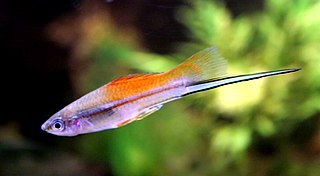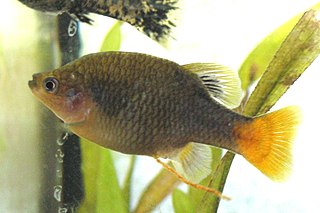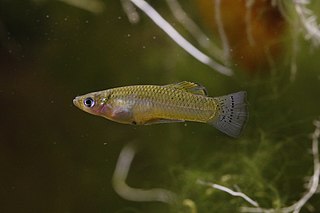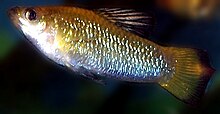
The Poeciliidae are a family of freshwater fishes of the order Cyprinodontiformes, the tooth-carps, and include well-known live-bearing aquarium fish, such as the guppy, molly, platy, and swordtail. The original distribution of the family was the Southeastern United States to north of Río de la Plata, Argentina, and Africa, including Madagascar. Due to release of aquarium specimens and the widespread use of species of the genera Poecilia and Gambusia for mosquito control, though, poeciliids can today be found in all tropical and subtropical areas of the world. In addition, Poecilia and Gambusia specimens have been identified in hot springs pools as far north as Banff, Alberta.

The western Mosquitofish is a species of freshwater fish, also known commonly, if ambiguously, as simply Mosquitofish or by its generic name, Gambusia, or by the common name gambezi. Its sister species, the eastern mosquitofish is also referred to by these names.

Gambusia is a large genus of viviparous fish in the family Poeciliidae. Gambusia contains over 40 species, most of which are principally found in freshwater habitats, though some species may also be found in brackish or saltwater habitats. The type species is the Cuban gambusia, G. punctata. The greatest species richness is in Mexico, Texas, and the Greater Antilles, but species are also found elsewhere in the eastern and southern United States, the Bahamas, Central America, and Colombia. Gambusia species are often called topminnows, or simply gambusias; they are also known as mosquitofish, which, however, refers more specifically to two species, G. affinis and G. holbrooki, which are often introduced into ponds to eat mosquito larvae. As a consequence, they have been introduced widely outside their native range, and frequently become invasive, threatening local species. They are only occasionally kept in aquariums, due to their relative lack of color and the highly aggressive nature of the aforementioned mosquitofish species.

Xiphophorus is a genus of euryhaline and freshwater fishes in the family Poeciliidae of order Cyprinodontiformes, native to Mexico and northern Central America. The many Xiphophorus species are all known as platyfish and swordtails. Platyfish formerly were classified in another genus, Platypoecilia, which is now obsolete. The type species is X. hellerii, the green swordtail. Like most other new world Poeciliids, platies and swordtails are live-bearers that use internal fertilization and give birth to live young instead of laying eggs like the bulk of the world's fishes. The name Xiphophorus derives from the Greek words ξίφος (dagger) and φόρος (bearer), referring to the gonopodium on the males. All are relatively small fishes, which reach a maximum length of 3.5–16 cm (1.4–6.3 in) depending on the exact species involved.

Poecilia is a genus of fishes in the family Poeciliidae of the order Cyprinodontiformes. These livebearers are native to fresh, brackish and salt water in the Americas, and some species in the genus are euryhaline. A few have adapted to living in waters that contain high levels of toxic hydrogen sulfide and a population of P. mexicana lives in caves.

The sailfin molly is a species of fish of the genus Poecilia. They inhabit fresh, brackish, salt, and coastal waters from North Carolina to Texas and the Yucatán Peninsula of Mexico.
Lake Miragoâne is a lake in Haiti, located one kilometer southeast of the city of Miragoâne. It is one of the largest natural freshwater lakes in the Caribbean. The lake is 12 km (7.5 mi) long and 25 km² (9.7 mi²) in area.

Heterandria is a genus of livebearing fishes within the family Poeciliidae. Most species occur in Guatemala and its surroundings, particularly Mexico, but the midget livebearer (H. formosa) comes from the southeastern United States.

Heterandria formosa is a species of livebearing fish within the family Poeciliidae. This is the same family that includes familiar aquarium fishes such as guppies and mollies. Heterandria formosa is not as commonly kept in aquaria as these species. Despite the common name "least killifish", it belongs to the family Poeciliidae and not to one of the killifish families. H. formosa is one of the smallest fish species; the 1991 Baensch Aquarium Atlas listed it as the 7th smallest fish in the world, and as of 2006 it remains the smallest fish species found in North America.

The redtail splitfin or redtail goodeid is a species of goodeid fish from the family Goodeidae and subfamily Goodeinae. Like other members of Goodeinae, the redtail splitfin is native to Mexico and a livebearer. However, the goodeid mating system differs in several ways from the more common livebearing fish from the family Poeciliidae that includes guppies and swordtails. While no goodeid species is a very popular aquarium fish, the redtail splitfin is one of the most popular. Only the male has the red-orange tail for which it is named. Its specific name honours the collector of the type, Gustav Eisen (1847–1940) who was Curator of Marine Invertebrates at the California Academy of Sciences in San Francisco, California.

Neoheterandria elegans or Tiger Teddy is a small live-bearing fish within the family Poeciliidae. This is the same family that includes familiar aquarium fishes such as guppies and swordtails, although Neoheterandria elegans is not nearly as popular as an aquarium fish. The fish is found in the Truando River in Colombia. Males grow to 2.0 centimetres (0.79 in) and females grow to 2.5 centimetres (0.98 in). The front half of the fish is mostly silver but the rear has alternating gold and black vertical bars.

Helicolenus dactylopterus, blackbelly rosefish, bluemouth rockfish, and bluemouth seaperch, is a species of marine ray-finned fish belonging to the subfamily Sebastinae which is classified within the family Scorpaenidae. This Atlantic species is a typical sit-and-wait predator with a highly cryptic coloration.

Xiphophorus continens, also known as El Quince swordtail or short-sword platyfish, is a live-bearing freshwater fish in the family Poeciliidae. It is endemic to the Pánuco River basin in east-central Mexico. Its name comes from the Greek conto, meaning short, and Latin ensis, meanin "sword". due to the species' sword size in males.

Poeciliinae is a subfamily of killifish from the family Poeciliidae which contains species from the Americas which are collectively known as the livebearers because many, but not all, of the species within the subfamily are ovoviviparous.
Limia melanonotata, the blackbanded limia, is a toothcarp in the family Poeciliidae. It is endemic to the island of Hispaniola.

The Hispaniolan gambusia is a fish endemic to the island of Hispaniola.

The Cuban limia, also known as banded limia, Cuban molly, Cuban topminnow or tabai is a species of livebearing freshwater fish from the family Poeciliidae. The species is native to Cuba where it was endemic but it has been introduced to Hawaii.

Poecilia parae is a species of fish from the family Poeciliidae which is found in northern South America from Guyana to the mouth of the Amazon River.

Limia sulphurophila, also known as sulphur limia, is a livebearing fish in the family Poeciliidae. It is endemic to the Dominican Republic in the island of Hispaniola.

Limia islai, also known as the tiger limia, is a species of fish within the family Poeciliidae. This species is one of several Limia, which are endemic to Lake Miragoâne, Haiti.

















